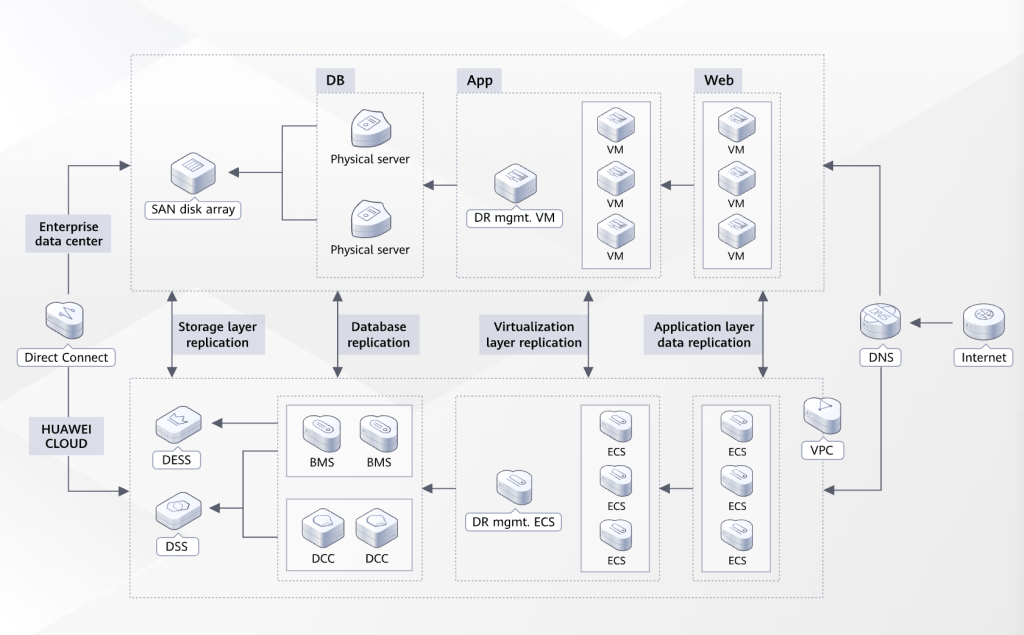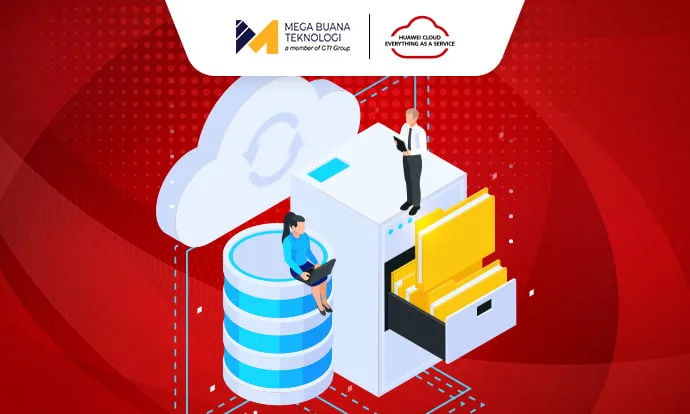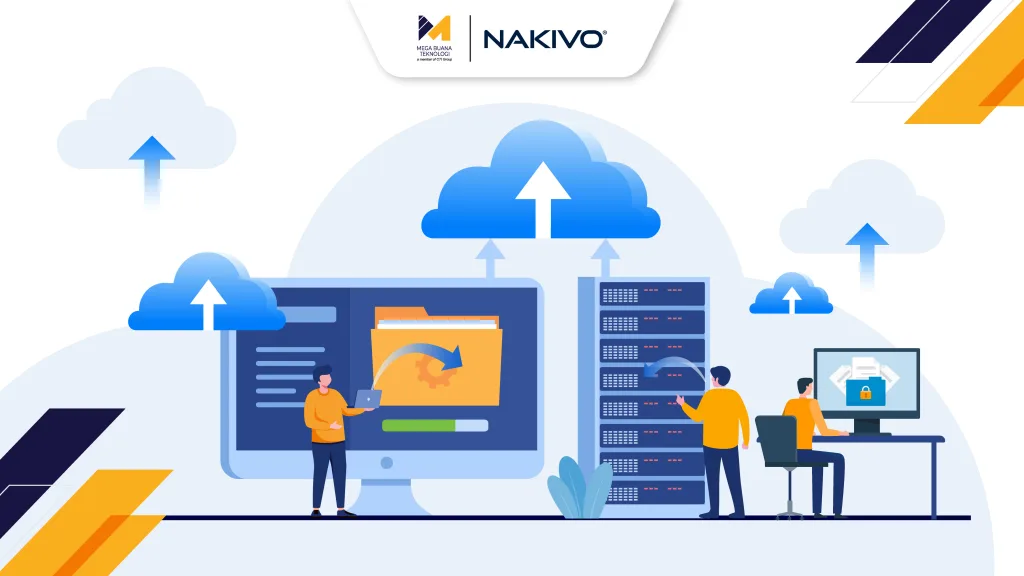The rapid growth of cloud computing and the increasing demands of modern businesses have driven many companies to migrate their services to cloud infrastructure. While this move offers scalability and cost efficiency, it also introduces significant challenges in ensuring service continuity, particularly in terms of security and operational stability, which are more critical than ever in today’s digital era.
Although cloud delivers economic advantages and helps address environment bottlenecks, traditional disaster recovery models—such as geo-redundant setups with two sites and three data centers—are often insufficient when it comes to mitigating disruptions caused by system failures. To overcome these limitations, hybrid cloud disaster recovery has emerged as a more flexible and resilient solution. By combining the strengths of cloud and on-premises infrastructure, it ensures uninterrupted business operations even in the face of unexpected incidents.
This article explores the importance of disaster recovery and how hybrid cloud-based solutions can help organizations minimize risk and maintain seamless business continuity, even in times of crisis.
What is Disaster Recovery?
Disaster recovery refers to a set of processes and strategies that enable organizations to restore access to IT systems and infrastructure affected by disasters—whether cyberattacks, human errors, natural disasters, or other disruptive events. Its main objective is to ensure that critical data and information systems can be quickly recovered, allowing businesses to resume operations with minimal downtime.
5 Types of Disaster Recovery
Every business faces unique challenges when it comes to safeguarding operations and data. For this reason, multiple disaster recovery strategies have been developed to address different needs.
1. Data Center Disaster Recovery
Focuses on securing physical IT infrastructure and backups. This approach typically relies on failover sites at separate locations to maintain operations in case of outages at the primary data center.
2. Cloud Disaster Recovery
Leverages cloud solutions to replicate and host both physical and virtual servers. Workloads can automatically failover to the public cloud during disasters, eliminating the need for a secondary physical site.
3. Network Disaster Recovery
Ensures network availability by maintaining backup data and standby sites. This strategy also includes procedures to restore control of network services when disruptions occur.
4. Virtualized Disaster Recovery
Replicates workloads to the cloud or an alternate physical site, offering greater flexibility and efficiency in system recovery.
5. Disaster Recovery as a Service (DRaaS)
A managed service provided by third parties to duplicate and host company servers. The provider is responsible for implementing and managing the most suitable disaster recovery strategy for each business.
Business Challenges in Implementing a Disaster Recovery Plan
Implementing disaster recovery is not without its challenges. Businesses often face several key obstacles, including:
Limitations in Conducting Disaster Recovery Drills
Traditional disaster recovery drills require strict scheduling and activation of backup systems, often increasing the risk of errors or delays. In critical situations, failed switchover attempts can leave businesses vulnerable to prolonged downtime.
High Costs of Building and Maintaining Disaster Recovery Centers
Establishing and operating disaster recovery sites demands heavy capital (CAPEX) and operational (OPEX) investments, including facilities, staffing, and testing—often straining company budgets.
Complex Architecture
Multi-site disaster recovery architectures require significant investments and complex design planning, making traditional models costly and difficult to implement efficiently.
Complicated Data Synchronization Policies
Synchronizing data across hosts, databases, and storage devices is often hindered by transmission distance and data volume. Encryption and decryption processes add further complexity, potentially affecting data validity and Recovery Point Objectives (RPOs).
Multi-Cloud Management Complexity
Managing hybrid cloud involves coordinating multiple providers. Key challenges include data integration, consistent security policies, and managing latency. Without proper governance, risks of misconfiguration and data loss increase significantly.
Security Challenges in Hybrid Cloud
Each cloud provider operates with different security standards, complicating efforts to maintain consistent data protection. With sensitive information spread across multiple clouds, unified and efficient security strategies become essential.
Understanding Hybrid Cloud Disaster Recovery
Hybrid cloud disaster recovery combines the scalability and flexibility of the cloud with the security and control of on-premises infrastructure. Organizations can store mission-critical data on-premises while leveraging the cloud for backup and recovery, reducing storage footprints and costs while ensuring optimal data protection.
To maximize its benefits, businesses must adopt the right hybrid cloud disaster recovery solution tailored to their scale and operational needs. Huawei Cloud delivers purpose-built disaster recovery solutions designed to support hybrid cloud deployments, offering high efficiency, reliability, and business continuity.
Strengthening Security and Reliability with Huawei Hybrid Cloud Disaster Recovery
Huawei Hybrid Cloud Disaster Recovery provides an innovative, cost-efficient solution for protecting business data and operations. With features such as Cross-Cloud Backup and Cross-Cloud Disaster Recovery, Huawei Cloud ensures secure, rapid recovery from various disaster scenarios. It supports Linux, Windows, and virtualization platforms such as KVM, Xen, and VMware, making it an ideal choice for organizations seeking full disaster recovery coverage.
By eliminating the need for physical disaster recovery facilities, Huawei Cloud helps businesses achieve significant cost savings. The solution also enables fast, on-demand drills—allowing companies to run recovery simulations in just a few hours. With its reliability and flexibility, Huawei Hybrid Cloud Disaster Recovery ensures business operations remain uninterrupted, even during major disruptions.
Why Huawei Hybrid Cloud is the Right Fit for Modern Businesses
Huawei Hybrid Cloud combines reliability, scalability, and cost-efficiency to address the challenges of today’s fast-moving business environment, where downtime can have serious financial and reputational impacts.
Backed by advanced technologies and years of disaster recovery expertise, Huawei Cloud is the right choice for businesses seeking to protect data while maintaining seamless operations.
Backup and Disaster Recovery Scenarios with Huawei Cloud DR
Huawei Cloud Disaster Recovery supports a wide range of scenarios with flexible, reliable solutions:
Cross-Cloud Backup

Figure 1. Illustration of a Cross-Cloud Backup Scenario with Huawei Hybrid Cloud Disaster Recovery
Enables secure cross-cloud backups, protecting data across multiple cloud environments. Data is encrypted throughout storage and transmission, with durability of up to 99.9999%. By using deduplication and compression, storage costs can be reduced by 20–80%, making it both effective and economical.
Cross Cloud-DR Disaster Recovery

Figure 2. Illustration of a Cross-Cloud DR Backup Scenario with Huawei Hybrid Cloud Disaster Recovery
Provides fast, effective data and system recovery across cloud environments. Using asynchronous replication, data from storage, databases, and applications is replicated in real time, ensuring rapid recovery with minimal downtime.
On-Cloud Disaster Recovery

Figure 3. Illustration of an On-Cloud Disaster Recovery Scenario with Huawei Hybrid Cloud Disaster Recovery
Covers both cross-Availability Zone (AZ) and cross-region recovery scenarios, delivering maximum flexibility with zero RPO—ensuring no data loss during recovery. Multi-AZ and multi-region architectures ensure uninterrupted services even when failures occur at one or more sites.
MBT: Your Trusted Partner for Huawei Hybrid Cloud Disaster Recovery Implementation
As an authorized Huawei Cloud partner, Mega Buana Teknologi (MBT) offers customized solutions to help organizations successfully implement hybrid cloud disaster recovery. MBT supports businesses in improving operational efficiency, optimizing resource utilization, and reducing infrastructure management costs.
Through its partnership with Huawei, MBT provides access to cutting-edge technology backed by a team of experienced professionals—ensuring seamless implementation and reliable operations of your disaster recovery systems.
For more information on Huawei Hybrid Cloud Disaster Recovery solutions from MBT, contact us today.
Author: Danurdhara Suluh Prasasta
Content Writer Intern CTI Group




